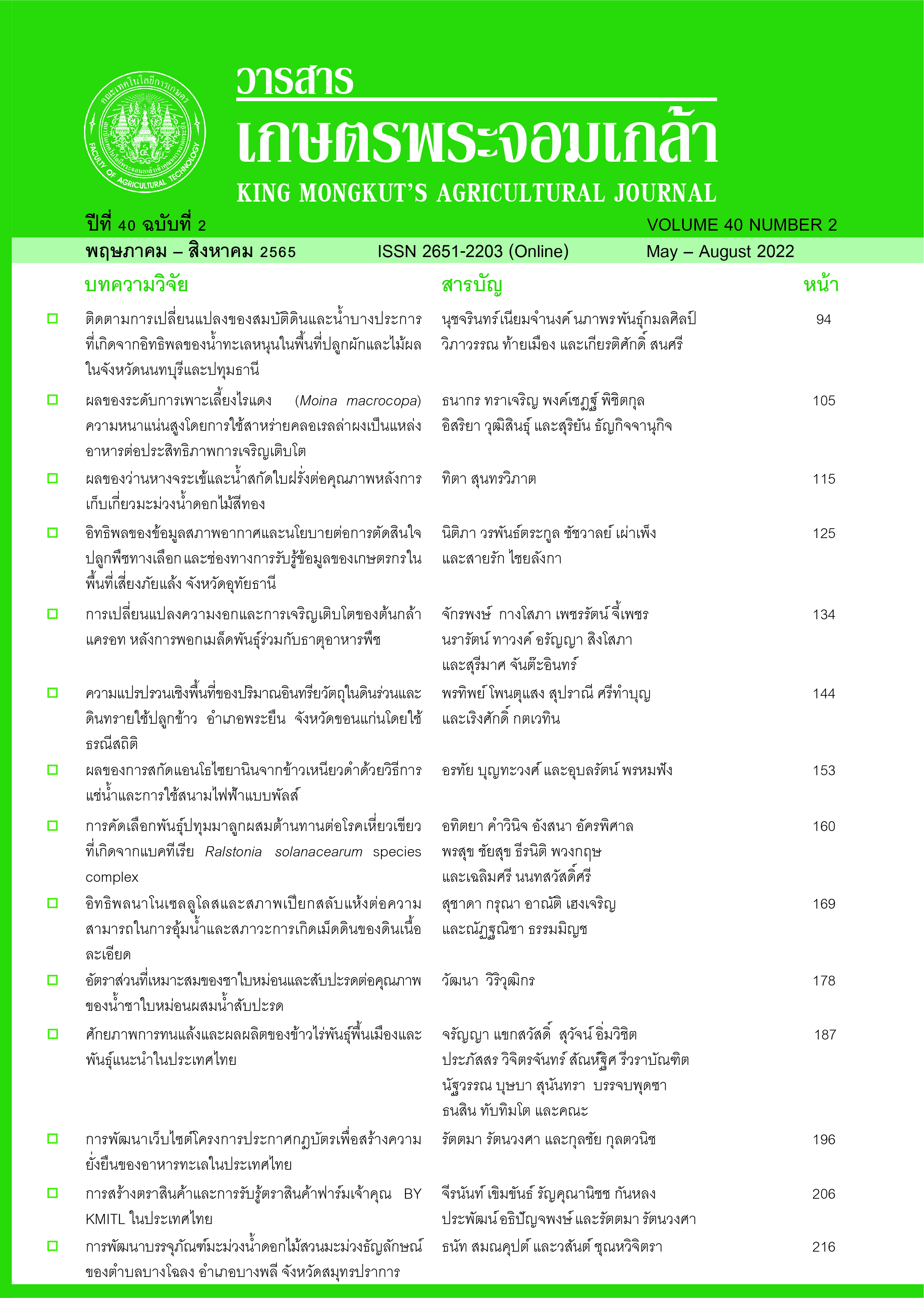อิทธิพลนาโนเซลลูโลสและสภาพเปียกสลับแห้งต่อความสามารถในการอุ้มน้ำและสภาวะการเกิดเม็ดดินของดินเนื้อละเอียด
Main Article Content
บทคัดย่อ
การระบายน้ำและอากาศเป็นปัญหาสำคัญของดินเนื้อละเอียดที่ใช้เพาะปลูกพืช เนื่องจากอนุภาคดินเหนียวมีขนาดเล็กและรูปร่างเป็นแผ่นอัดตัวแน่นง่าย ทำให้การระบายน้ำและอากาศไม่ดี ส่งผลต่อการเจริญเติบโตของรากพืชและกิจกรรมของจุลินทรีย์ดิน การส่งเสริมการเกิดเม็ดดินในดินเนื้อละเอียดจะช่วยเพิ่มช่องระบายน้ำและอากาศในดินได้ วิธีการปรับปรุงที่นิยมส่วนใหญ่ คือ ใส่อินทรียวัตถุหรือสารอินทรีย์ต่าง ๆ ลงไปในดิน ซึ่งใช้ระยะเวลาค่อนข้างนาน งานวิจัยนี้จึงมีวัตถุประสงค์เพื่อ ประยุกต์ใช้นาโนเซลลูโลสและทดสอบอิทธิพลของสภาพเปียกสลับแห้งของดินเมื่อผสมนาโนเซลลูโลสต่อความสามารถในการอุ้มน้ำและสภาวะการเกิดเม็ดดินของดินเนื้อละเอียด โดยผสมดินกับนาโนเซลลูโลส 4 ระดับความเข้มข้น คือ 1, 1.3, 2 และ 4 เปอร์เซ็นต์ (สัดส่วนนาโนเซลลูโลสต่อดินโดยน้ำหนัก) จากนั้นทำให้ของผสมผ่านสภาพเปียกสลับแห้งจำนวน 3 รอบ ตรวจวัดความสามารถในการอุ้มน้ำ (water-holding capacity; WHC) การเปลี่ยนแปลงขนาดเฉลี่ยเม็ดดินแบบถ่วงน้ำหนัก (change in mean weighted diameter; CMWD) สถานะการเกิดเม็ดดิน (state of aggregation; SA) และการกระจายขนาดของช่อง หลังผ่านสภาพเปียกสลับแห้งสามรอบ (pore-size distribution; PSD) ผลการทดลองพบว่า สัดส่วนนาโนเซลลูโลสที่สูง (2 และ 4 เปอร์เซ็นต์) ช่วยเพิ่มความสามารถในการอุ้มน้ำได้มากกว่าสัดส่วนนาโนเซลลูโลสที่ต่ำ (1 และ 1.3 เปอร์เซ็นต์) สภาพการเปียกสลับแห้งที่นานขึ้นทำให้ค่า WHC เพิ่มขึ้น สำหรับสภาวะการเกิดเม็ดดิน นาโนเซลลูโลสในสัดส่วนที่สูง (2 และ 4 เปอร์เซ็นต์) ส่งเสริมสภาวะการเกิดเม็ดดิน (SA สูง) และความคงทนของเม็ดดิน (CMWD น้อย) สภาพการเปียกสลับแห้งที่นานขึ้นทำให้ความคงทนของเม็ดดินลดลง นอกจากนี้พบว่า นาโนเซลลูโลสที่ความเข้มข้นสูงทำให้สัดส่วนช่องระบายน้ำและอากาศในดินเนื้อละเอียด (> 30 mm) เพิ่มขึ้นด้วย
Article Details

อนุญาตภายใต้เงื่อนไข Creative Commons Attribution-NonCommercial-NoDerivatives 4.0 International License.
วารสารเกษตรพระจอมเกล้า
เอกสารอ้างอิง
คณาจารย์ภาควิชาปฐพีวิทยา. 2541. ปฐพีวิทยาเบื้องต้น. พิมพ์ครั้งที่ 9. กรุงเทพฯ: สำนักพิมพ์มหาวิทยาลัยเกษตรศาสตร์.
พิมพันธ์ เจิมสวัสดิพงษ์. 2549. สมบัติและสภาวะทางฟิสิกส์ของดิน. พิมพ์ครั้งที่ 1. กรุงเทพฯ: สำนักพิมพ์มหาวิทยาลัยเกษตรศาสตร์.
สัญชัย ภู่เงิน. 2558. คู่มือปฏิบัติการ วิชาการวิเคราะห์ดินทางฟิสิกส์. นครปฐม: ภาควิชาปฐพีวิทยา คณะเกษตร กำแพงแสน มหาวิทยาลัยเกษตรศาสตร์.
Abitbol, T., Rivkin, A., Cao, Y., Nevo, Y., Abraham, E., Ben-Shalom, T., Lapidot, S., and Shoseyov, O. 2016. Nanocellulose, a tiny fiber with huge applications. Current Opinion in Biotechnology 39: 76-88.
Bauli, C.R., Lima, G.F., de Souza, A.G., Ferreira, R.R., and Rosa, D.S. 2021. Eco-friendly carboxymethyl cellulose hydrogels filled with nanocellulose or nanoclays for agriculture applications as soil conditioning and nutrient carrier and their impact on cucumber growing. Colloids and Surfaces A: Physicochemical and Engineering Aspects 623: 126771. https://doi.org/10.1016/j.colsurfa.2021.126771 (8 September 2021).
Bodner, G., Scholl, P., and Kaul, H.P. 2013. Field quantification of wetting–drying cycles to predict temporal changes of soil pore size distribution. Soil & Tillage Research 133(2013): 1-9.
Cao, Y., Wang, B., Guo, H., Xiao, H., and Wei, T. 2017. The effect of super absorbent polymers on soil and water conservation on the terraces of the loess plateau. Ecological Engineering 102(2017): 270-279.
Choudhary, M.I., Shalaby, A.A., and Al‐Omran, A.M. 1995. Water holding capacity and evaporation of calcareous soils as affected by four synthetic polymers. Communications in Soil Science and Plant Analysis 26(13-14): 2205-2215.
Demitri, C., Scalera, F., Madaghiele, M., Sannino, A., and Maffezzoli, A. 2013. Potential of cellulose-based superabsorbent hydrogels as water reservoir in agriculture. International Journal of Polymer Science 2013: 1-6.
Field, D. J., McKenzie, D. C., and Koppi, A. J. 1997. Development of an improved vertisol stability test for SOILpak. Australian Journal of Soil Research 35: 843-852.
Hazelton, P., and Murphy, B. 2007. Water-holding properties. In Interpreting Soil Test Results: What do all the numbers mean?. Australia: CSIRO Publishing.
Jiang, F., and Hsieh, Y. 2014. Super water absorbing and shape memory nanocellulose aerogels from TEMPO-oxidized cellulose nanofibrils via cyclic freezing–thawing. Journal of Materials Chemistry A 2: 350-359.
Kalkan, E. 2011. Impact of wetting–drying cycles on swelling behavior of clayey soils modified by silica fume. Applied Clay Science 52: 345-352.
Neramitkornburi, A., Horpibulsuk, S., Shen, S.L., Chinkulkijniwat, A., Arulrajah, A., and MiriDisfani, M. 2015. Durability against wetting–drying cycles of sustainable lightweight cellular cemented construction material comprising clay and fly ash wastes. Construction and Building Materials 77(2015): 41-49.
Phanthong, P., Reubroycharoen, P., Hao, X., Xu, G., Abudula, A., and Guan, G. 2018. Nanocellulose: extraction and application. Carbon Resources Conversion 1(2018): 32-43.
Picek, T., Šimek, M., and Šantrucková, H. 2000. Microbial responses to fluctuation of soil aeration status and redox conditions. Biology and Fertility of Soils 31: 315-322.
Sayem, H. M., and Kong, L. 2016. Effects of drying-wetting cycles on soil-water characteristic curve. In 2016 International Conference on Power Engineering & Energy, Environment (PEEE 2016) ISBN: 978-1-60595-376-2.
Sehaqui, H., Zhou, Q., Ikala, O., and Berglund, L.A. 2011. Strong and tough cellulose nanopaper with high specific surface area and porosity. Biomacromolecules 12(10): 3638-3644.
Tang, C. S., Cui, Y. J., Shi, B., Tang, A. M., and Liu, C. 2011. Desiccation and cracking behaviour of clay layer from slurry state under wetting–drying cycles. Geoderma 166(2011): 111-118.
Tang, C. S., Cui, Y. J., Shi, B., Tang, A. M., and An, N. 2016. Effect of wetting-drying cycles on soil desiccation cracking behaviour. In 3rd European Conference on Unsaturated Soils – “E-UNSAT 2016”. E3S Web of Conferences: Vol. 9, 12003.
Williams, J., Prebble, R. E., Williams, W. T., and Hignett, C. T. 1983. The influence of texture, structure and clay minerology on the soil moisture characteristic. Australian Journal of Soil Research 21: 15-32.


